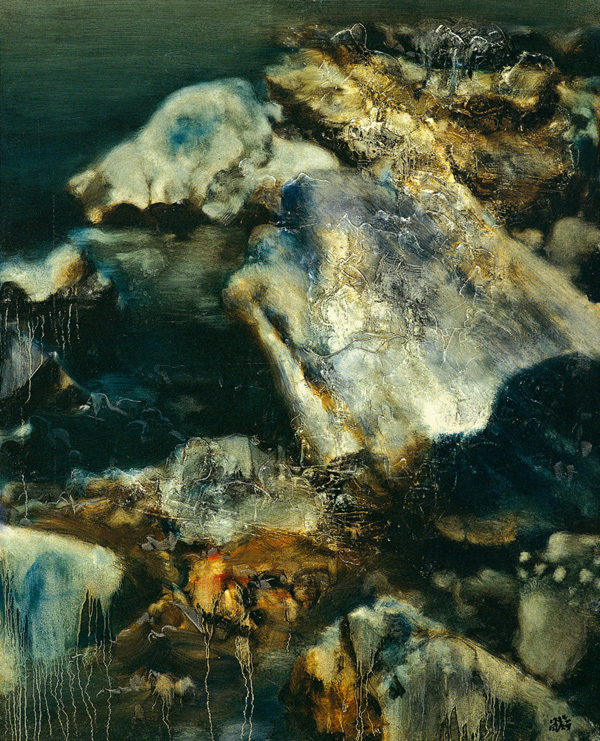ILLUSTRATED:
Chinese Oil Painting in the 20th Century III-1, Beijing Publishing Co., published by Beijing Arts, 2001 color illustrated, p. 141
Liu Chun, History of Chinese Oil Painting, Beijing, 2005, color illustrated, p. 326
Blooming Stories, Sichuan Fine Art Publishing Co., Sichuan, 2007, color illustrated, p. 17
Catalogue Note:
As early as the 1990's Zhou turned to the use of all new techniques in re-interpreting the traditional Chinese mountain rock. Mountain rock is a traditional theme in Chinese painting, reflecting the spirit of the literati and serving as a bastion for the soul. In Zhou's painting a completely different aspect of mountain rock is revealed. Colors not found in nature are used to express the nature of the rocks themselves.
"Stone is a symbol of nature. The strength and completeness of the Stone allows the artist to fully express their own spirit and practice their painting skills." (By Zhou Chunya)
In Stone - A View to Ya'anshangli, the rocks with unnatural colors are themselves covered by a layer of strange growth to hint at their fuzziness in their natural essence. Using his favorite medium of oil colors, the artist draws on the techniques of the West's New Expressionism to separate the brush strokes from the background. A variety of methods are then used to express the rigid objects that are to be identified. The fearless use of colors to give an interpretation of mountain rock and flowers give the painting and the scenery a strange exotic flavor. The loose brush strokes and lack of distinct outlines suggest a free flowing painting style. The inspiration for this artwork was based on reality so the image is more instantiated. The curved form that was the painting' s focus was directly inspired by the artist' s many photos from Taihu. One detail in the image adds a touch of anxiety to the work. This also made it more subjective and surprising. The hollowness of the mountain rock was created using a pale black. This was developed from traditional art and expressed on the canvas using an unusual acrylic paint. This represented the pull of opposites in the artist's character - his past and present, China and the West, the "pale white" and deep shadows. In Da Vinci's painting the clouds and color blocks all have an indistinct outline so the artist could give his own imagination free rein. The mountain rock depicted by Zhou gives him the opportunity to unleash his creativity in much the same way. His full brush strokes make use of existing painting traditions without being restricted by them.
When I was painting "Stone-A View to Ya'anshangli" I had been studying the landscape paintings of the literati. Unlike Chinese painters, I did not try to understand them in terms of their texture or compositions. Instead, I let what I wanted to express seek out the unfamiliar and surprising elements. To get the right texture and feel I spent a great deal of time compulsively trying to capture and appreciate the visual elements hidden with the essence of the rock itself. These were then reinforced and the essence amplified. The visual representation is then itself the content so there's no need for extra explanations or references. The result are rocks more surprising and stunning than those that you see or understand from a conceptual and technical perspective. (by Zhou Chunya)
Whi le Zhou l iked the forms of the rocks in classical literati paintings, he was not satisfied with their excessively reserved and introspective character. He therefore attempted something brash and adventurous – borrowing the classical forms to convey violent – or even sexual – connotations. The existence of manmade obstacles between these two kinds of visual aesthetics have led to certain fixed expectations. This unification of art aesthetics then became a habitual rejection of the unusual. In response, Zhou used rich textiles and transposition of textures to transform the impression of paleness and softness from traditional ink paintings. A complex structure replaced the flat visual impression of literati paintings so that everything from the colors to the composition feels as if there were demons let loose. This attempt to overturn the reasonable and natural resulted in a strange fruit.
